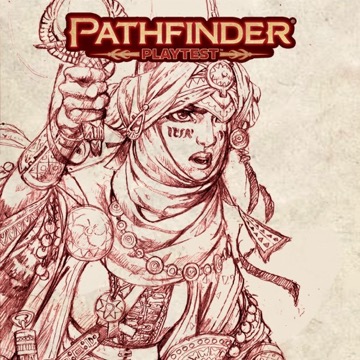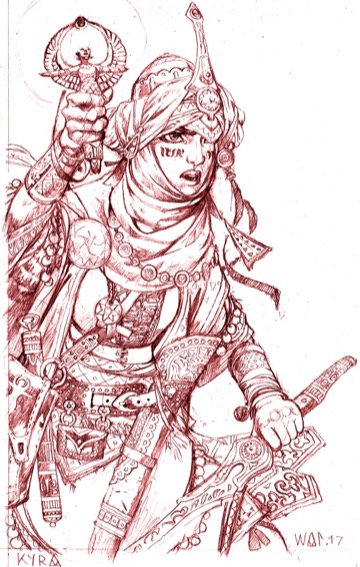Clerics are the first spellcasters to get a preview, so you might want to look at the blog about spells before you proceed! We have a lot to say about this class, so let's cut to the chase!
Cleric Features
Clerics' key ability score is Wisdom. This means that they get an ability boost to Wisdom at 1st level, increasing their Wisdom score by 2. They also use this key ability to determine the DC of their spells. Like other things in the Playtest, spells are also affected by your proficiency. Clerics are trained in divine spells, so they add 10 + their level + their Wisdom modifier for their spell DC. They use this same proficiency for touch attacks of their spells and for spell rolls.
At 1st level, clerics get several class features, including their deity and domain, anathema, channel energy, and of course, divine spellcasting (which we'll talk more about in a bit). Your deity has a major impact on your character, and you'll see a lot of similarities to Pathfinder First Edition, such as being trained in your deity's favored weapon and getting access to one of their domains. (Come back on Friday for a ton of detail about those parts of your character!) Your choice of domain gives you a unique domain power. Powers are a special type of spell that come only from your class, and are cast with Spell Points—think of things from Pathfinder First Edition like domain powers or a wizard's school powers. Powers are stronger than cantrips, but not as strong as your best spells. A cleric's initial power costs 1 Spell Point to cast. She gets a starting pool of Spell Points equal to her Wisdom, and can increase this by taking feats later on. If she gets other ways to cast powers of a different type, she combines all her Spell Points into one pool.
A cleric's deity also imposes some restrictions on her, collectively called anathema, representing acts that go against her deity's will and teachings or violate their alignment requirements. Though we give some examples of anathemic acts for the various gods and goddesses—like how it's anathema for a cleric of Sarenrae, goddess of honesty, to cast a spell that would help her lie better—we wanted to leave this broad enough that the GM and player can make the final say in how these work in their games. Many other classes that follow similar restrictions have their own anathema. Care to guess which ones those might be?
As you go up in level, you'll increase your proficiency rank with divine spells to expert at 12th level, master at 16th level, and legendary at 19th level.
Divine Spellcasting
Of course, the cleric's main feature is her divine spellcasting! At 1st level, you can cast two 1st-level spells each day, which you prepare from the selections on the divine spell list. Every time you gain an even level, you get one more spell slot per day of your highest level of spells (so at 2nd level, a cleric has three 1st-level spells per day). At every odd level, you get access to a new level of spells. You'll always be able to cast two or three spells of your highest level and three spells of every lower level, plus your cantrips and powers. Like your other spells, your 9th-level spells cap out at three spells, so at 19th level you become legendary in spellcasting instead. So what about your 10th-level spells? We'll talk about those in a future blog!
We made your number of spells more straightforward by eliminating Pathfinder First Edition's bonus spells granted for having a high ability score. Your Wisdom still matters greatly for your spell DC and other things important to clerics, but giving it slightly less weight makes it more practical now for you to play a cleric of Gorum who focuses on Strength and uses spells that don't involve your spell DC or that have decent effects even if your enemy succeeds at its save.
Now, it's not quite true to say those are all the spells you get. Remember channel energy from earlier? This feature lets you cast heal or harm an additional number of times per day equal to 3 + your Charisma modifier! Moreover, these spells are heightened to the highest level of spell you cast, so as soon as you hit 3rd level, all those heal or harm spells become 2nd-level spells. This replaces the Pathfinder First Edition cleric's spontaneous healing, which required her to sacrifice her prepared spells to make room for a heal spell. Now, you can use your channel energy to cast these extra heal spells, and if you think you'll need more healing than this provides, you can always prepare more heal spells using your normal spell slots (in fact, this can be a good use of some of your lower-level slots as you go up in level). Your choice of deity determines which spell you can cast with channel energy. Pharasma lets you cast heal, Rovagug makes you cast harm, and someone like Abadar or Lamashtu lets you choose your path at 1st level.
Cleric Feats
As we've mentioned before, we always wanted Pathfinder Second Edition to provide all classes with a sizeable number of options for customization. The cleric was one of the classes that had the most to gain, since a cleric got a bunch of class features at 1st level, then crickets for the rest of her career. The cleric's new class feats give her all sorts of new flexibility, so let's look at some of those!
At 1st level, you might pick Communal healing so when you cast heal to tend to a creature other than yourself, you regain some Hit Points too, or you might take Turn Undead, which forces undead that critically fail their saves against your heal spells to flee from you. (This works great with the 3-action version of heal!) You could also pick Expanded Domain to explore your deity's domains further, gaining the initial power from a different domain than the first one you chose. You can select this feat twice, letting you delve into a maximum of three domains!
At higher levels, you gain new cleric feats at every even level, except levels 12 and 16, when you increase your spell DCs instead. At 4th level, you might pick up Advanced Domain to gain the advanced power from one of your domains. At 8th level, if you channel positive energy, you could take the Channeled Succor feat so you can cast remove curse, remove disease, remove paralysis, or restoration with your channeled energy spells instead of just heal.
Let's take a look at a category of feats clerics have plenty of: metamagic! You can activate a metamagic feat when you cast a spell. This increases the number of actions required to cast the spell and modifies the spell in some way. At 1st level, for example, you could select Reach Spell to let you add a Somatic Casting action to a spell and increase its range by 30 feet (or to make a touch spell into a ranged touch spell with a 30-foot range). This is a metamagic feat lots of spellcasters can take, but the cleric gets some others that are more specific to her as well. Command Undead, a 4th-level feat, lets you change the effects of any harm spell you cast to instead take control of an undead creature. Heroic Recovery, an 8th-level feat, adds a powerful buff to heal spells: you can target one creature at range using 3 actions (the 2-action version of heal, plus another action to activate the metamagic) to heal them for a solid number of hit points and also give them a bonus to attack and damage rolls and a 5-foot increase to its speed for 1 round. And if you use a lot of metamagic, the 20th-level cleric feat Metamagic Channeler is a great choice—it lets you apply a metamagic feat to a harm or heal spell without adding an action to its casting!
So what are your favorite parts of the new cleric? Any builds you're itching to try out? How about concepts you made in Pathfinder First Edition you'd like to take another shot at?
Logan Bonner
Designer










